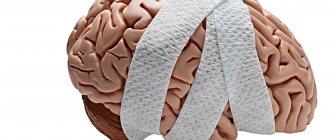Head neurosis is a mental disorder that occurs against the background of psychological overload, manifested by headaches and dizziness, which can be combined with other psycho-emotional and somatic symptoms: anxiety, restlessness, decreased performance, emotional lability, palpitations, disorders of the gastrointestinal tract and genitourinary organs.
Reasons for development
The cause of any neurosis is the impact of psychotraumatic factors: prolonged, mildly expressed stressful situations or one-time severe stress, lack of security, the inability to openly express feelings or implement plans, etc. If the listed circumstances exceed the mental capacity for self-healing, a breakdown in adaptation occurs, the person ceases to cope even with everyday life. loads. Predisposing circumstances are considered:
- Serious changes in life . Both negative and positive events matter. The development of a neurotic disorder can be caused by dismissal from work, the death of a loved one or family troubles, as well as a wedding, the birth of a child, or a large win in the lottery.
- Temperament type . Choleric and melancholic people are more prone to developing the disease. Stable types of temperament - phlegmatic and sanguine people - can also suffer from neuroses, but in them, due to the innate characteristics of the psyche, the disease develops with longer and more intense exposure.
- Constant overload . Large volumes of work, lack of sufficient rest, and inability to relax even on weekends gradually exhaust the nervous system and increase its susceptibility to traumatic influences.
- Other factors . Chronic intoxication and long-term somatic diseases create an increased burden on the body and predispose to the development of mental disorders.
Headaches due to neurosis
Patients with headaches are often depressed, they are constantly in a bad mood, and have reduced performance. And it is almost always quite difficult to figure out: is it headaches that lead to such an emotional state or are neurotic disorders leading to headaches? Let's try to understand what is the cause and what is the effect...
What is neurosis, why does it occur and what can it lead to?
Neurosis is a functional psychogenic reversible disorder that occurs in response to any sudden traumatic events or against the background of chronic stress. Neurosis does not develop in all people, but only in those who are predisposed to it, for example, have some peculiarities in the functioning of different parts of the nervous system.
The human brain has structures called the limbic system. It is responsible for emotions, instincts, drives, participates in the formation of memory, and regulation of the functioning of internal organs. Since the limbic system actively interacts with many other parts of the brain, it can influence the cardiovascular, respiratory, digestive systems, etc.
Different emotional reactions affect the functioning of internal organs; negative emotions can lead to disruption of the normal function of these organs. As a result, so-called psychosomatic diseases arise. In neurotic and depressive disorders, the pain threshold may also decrease. A person perceives the normal functioning of internal organs as painful stimuli. He goes to the doctor, but he does not find any diseases.
For the same reason, the patient may constantly be bothered by headaches. He became nervous, the muscles of the skull contract, and he felt it as pain. This is how tension headaches manifest themselves. MRI of the brain and other studies do not reveal any pathology. If there are any changes, for example, dystrophic changes in the substance of the brain as a manifestation of chronic cerebrovascular insufficiency, then they do not explain the appearance of these pains. Upon examination, one can only detect soreness in the muscles covering the skull, tension and soreness in the muscles of the neck and shoulder girdle.
In addition, neuroses can worsen the patient’s general condition and provoke an intensification of existing headaches of other origins. For example, migraine attacks may occur more frequently as a result of nervous tension.
Since a depressed mood can negatively affect the general condition of the body, in a person with neurosis, symptomatic headaches associated with damage to other organs and systems may also intensify.
What to do for headaches and neurosis
For chronic headaches and neuroses, the use of antidepressants is necessary. After all, neurotic disorders and chronic pain have common roots. These diseases are associated with disturbances in the metabolism of serotonin, norepinephrine and dopamine, which are involved in the transmission of nerve impulses, in the perception of pain, and the functioning of the limbic system.
Antidepressants, with long-term use, restore normal transmission of nerve impulses with the help of these substances. Modern antidepressants do not cause drowsiness and do not affect heart rate or blood pressure. The doctor selects the drug and dosage individually.
Where to go for headaches
There is a Pain Treatment Clinic in Saratov, where patients with headaches are consulted by doctors specializing in this problem. The clinic is located at: st. Bakhmetyevskaya 26/28. To schedule a consultation, please call.
Head symptoms
Headache with neurosis is in most cases observed in patients with hysteria and neurasthenia, and is rarely found in obsessive-compulsive disorder. When you refuse to acknowledge your feelings, the tendency to hide your experiences can come to the fore and occupy a leading place in the picture of the disease. Often combined with insomnia and decreased appetite. The cause is overstrain of the head and neck muscles, deterioration of blood supply to the brain due to changes in vascular tone. The most common options are the following:
- compressive diffuse pain covering the head in the form of a helmet;
- constant tension, a feeling of “cotton head”, which prevents memorization, analysis, planning, and solving intellectual problems;
- throbbing pain;
- migraine-like pain.
The predominant localization is the forehead, back of the head, temples. At the same time, it is often difficult to clearly indicate the epicenter or determine the nature of the sensations. Possible combination with weakness and nausea. Typically occurs or worsens after intense experiences.
Dizziness is observed in patients with panic attacks, phobias, anxiety disorders, depression, and vegetative-vascular dystonia. Non-systemic, combined with tinnitus, sometimes accompanied by pre-syncope. The psychogenic origin of the symptom is supported by the absence of hearing impairment and gait disorders. However, to exclude the organic origin of the pathology, a detailed examination is necessary.
Why is it developing?
The concept of neurasthenia was first introduced by the American physician George Beard in 1869. Then cases of the disease were identified in Germany and France. In Russia, they learned about the disorder in 1899. At the time, it was described as a state of periodic fatigue during adolescence. Gradually, the signs of neurasthenia were limited to a narrower framework.
The main cause of the disorder is stress and overwork. Stress can be:
- immediate, but of high intensity - the death of a loved one, loss of a job, divorce.
- systematic, but of lesser intensity, for example, caring for a seriously ill patient, psychological pressure from the boss and other recurring conflicts, inability to find a way out of the current situation.
A special role is given to overwork, both physical and mental, as well as lack of sleep and emotional stress.
An important link is a person’s way of thinking, behavior and the established value system, since often nervous tension and experiences arise against the background of the patient’s needs and capabilities that run counter to the realities of reality. However, in this situation, it is worth taking into account the level of adaptability to changing conditions, because each person reacts to the same circumstance differently: someone copes easily, with virtually no effort, while others experience great difficulties and stress.
Thus, the cause of neurasthenia are conditions that lead to disharmony of the nervous system, disturbing the balance between the processes of excitation and inhibition, causing its depletion.
The leading role belongs to professional stress, formed by three factors: a large amount of important information that must be learned, lack of time, and high ambitions. A similar situation is typical for people holding leadership positions that require high responsibility, or whose work takes place in a competitive environment. This type of neurasthenia is known under various names: informational, experimental neurosis; manager syndrome, white collar workers.
In addition to the main reasons, there are also predisposing factors:
- infections;
- severe, debilitating chronic diseases;
- intoxication;
- endocrine diseases;
- violation of the daily routine - insufficient rest;
- malnutrition, vitamin deficiency;
- bad habits – alcohol, smoking, drugs;
- traumatic brain injury;
- brain diseases - tumors, neuroinfections;
- intracranial hypertension.
Asthenic neurosis often affects people with an asthenic constitution (thinness, thin elongated limbs, narrow shoulders and chest). They are characterized by rapid fatigue and inability to withstand prolonged intense exercise, decreased mental tone and physical weakness.
Other signs
Along with the listed manifestations, the following may be observed:
- decreased sensitivity and paresthesia in the extremities;
- sleep disorders: difficulty falling asleep, frequent awakenings, disturbing dreams and nightmares, early awakenings or, on the contrary, too much sleep in the morning with problems at night, daytime sleepiness;
- inability to fully relax even when very tired;
- mood swings, anxiety, restlessness, irritability, depression, inability to experience positive emotions;
- cognitive impairment, decreased intellectual abilities;
- weakness, fatigue, apathy, touchiness, tearfulness;
- tendency to get “stuck” in experiencing a stressful situation;
- causeless pain in the body;
- increased sensitivity to external stimuli: loud sounds, bright light, temperature changes;
- autonomic disorders: dyspepsia, blood pressure instability, palpitations, increased sweating;
- decreased sexual desire, sexual dysfunction;
- loss of appetite, difficulty eating due to insufficient saliva production;
- attacks of anxiety and fear not related to external circumstances.
The severity and number of symptoms vary significantly - some patients exhibit 1 or 2 symptoms from the list above, others exhibit all or almost all manifestations.
A characteristic feature is the presence of muscle tension that occurs due to constant overexertion. Their localization is determined by prevailing experiences. Hostility towards others provokes an increase in the tone of the shoulder girdles and upper limbs. Sexual problems cause tension in the muscles of the pelvis and hips. The feeling of constant tension in the head is associated with decreased self-esteem and unresolved external and internal conflicts.
Example from life
A 43-year-old patient complains of headaches in the frontal region, bad mood, and excessive groundless irritability. There is a constant feeling of fear of going crazy, of contracting syphilis, which is why the patient is accompanied by a feeling of timidity.
The symptoms have been bothering the woman for 6 months. She notes the presence of such things as touchiness, shyness, and impressionability.
She studied well at school, is hardworking, diligent, works a lot, and has good endurance.
She was married twice, her first husband died. The second husband abused alcohol and showed physical violence towards her. When he infected a woman with syphilis, the patient overly experienced this fact as a shame.
I was very worried about the relationship with my husband and the divorce, I worked a lot and hard. Soon she began to systematically experience headaches, noise, pain and itching appeared in the ears. For this reason I had to consult an ENT doctor. Treatment was carried out, but there was a feeling that ulcers had formed in the ears. She became irritable, had trouble sleeping, and was almost constantly in a bad mood. The headaches were getting worse.
I turned to another specialist. He peered long and intently at the patient and remained silent, which is why the woman concluded that syphilis had returned. She became very scared, stopped sleeping at night, and constantly went to doctors.
Her condition worsened, anxiety grew, indescribable sensations appeared in her head, she exploded at the slightest provocation. At some point, she decided that she was going crazy and turned to a psychiatrist for help. After a proper examination, she was diagnosed with neurasthenia with obsessions.
Obsessive sensations with neurasthenia are a fairly common symptom. As a rule, they stem from hypochondriacal thoughts that acquire a stable, severe character.
Cost of services
| CONSULTATIONS OF SPECIALISTS | |
| Initial consultation with a psychiatrist (60 min.) | 6,000 rub. |
| Repeated consultation | 5,000 rub. |
| Consultation with a psychiatrist-narcologist (60 min.) | 5,000 rub. |
| Consultation with a psychologist | 3,500 rub. |
| Consultation with Gromova E.V. (50 minutes) | 12,000 rub. |
| PSYCHOTHERAPY | |
| Psychotherapy (session) | 7,000 rub. |
| Psychotherapy (5 sessions) | 30,000 rub. |
| Psychotherapy (10 sessions) | 60,000 rub. |
| Group psychotherapy (3-7 people) | 3,500 rub. |
| Psychotherapy session with E.V. Gromova (50 minutes) | 12,000 rub. |
This list does not contain all prices for services provided by our clinic. The full price list can be found on the “Prices” , or by calling: 8(969)060-93-93. Initial consultation is FREE!
Treatment
Comprehensive therapeutic measures are recommended, including drug support, psychotherapy and lifestyle changes. You should review your daily routine and the amount of exercise, rest regularly, move enough, and eat well. As part of drug treatment, the following is prescribed:
- herbal remedies with a sedative effect: motherwort, valerian, peony tincture, etc.;
- painkillers, preferably those that simultaneously eliminate muscle and vascular spasms;
- anti-anxiety medications, nootropics, sleeping pills;
- vitamin and mineral complexes.
In severe cases, antidepressants are indicated. The use of these medications in various combinations helps eliminate pain, normalize muscle tone, restore sleep and appetite, and reduce the severity of emotional experiences.
The type of psychotherapeutic correction is determined by the type and severity of the cerebral neurosis and the patient’s personal characteristics. Cognitive-behavioral and psychodynamic techniques, art therapy and other areas are used. In some cases, hypnosis is effective. The following physical methods are used to reduce muscle tension:
- water procedures;
- relaxation massage;
- aromatherapy;
- reflexology;
- special manual techniques.
After eliminating the symptoms, it is necessary to follow certain rules to avoid relapse of the disease. When planning your schedule, you should leave enough time for rest, maintain moderate physical activity, regularly spend time in the fresh air, do not refuse vacations, avoid overtime, and avoid stress if possible.
Treatment methods for neurasthenia
The treatment tactics for neurosis are determined by the doctor depending on the severity of the pathology. In some cases, you can get rid of HP using psychotherapy alone. Properly selected psychologist activities are the fundamental technique for treating neurasthenia. The reversibility of neurosis and a positive reaction to mental influences allows you to quickly achieve healthy thinking. Based on the specifics of the methods, there are:
Pathogenic. Designed to fight the root cause. They help identify conflict, resolve internal contradictions, and mitigate childhood trauma, the consequences of which have become a pathology in adulthood. The most effective methods of therapy are: psychodynamic, systemic, cognitive, integrative.
Symptomatic. They allow you to correct behavior during stressful situations, help lay down the principles of objective perception, and independently stop panic symptoms. They use hypnotherapy, breathing techniques, and relaxing painting.
Sometimes the diagnosis requires medical intervention. Usually, drugs act as a “second fiddle” to achieve rapid physical and mental relief. These products should only be consumed under the supervision of a specialist. The drugs have a wide range of limitations and side effects.









